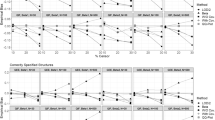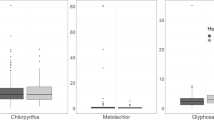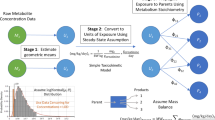Abstract
Background
Most methods for treating left-censored data assume the analyte is present but not quantified. Biased estimates may result if the analyte is absent such that the unobserved data represents a mixed exposure distribution with an unknown proportion clustered at zero.
Objective
We used semi-continuous models to identify time and industry trends in 52,457 OSHA inspection lead sample results.
Method
The first component of the semi-continuous model predicted the probability of detecting concentrations ≥ 0.007 mg/m3 (highest estimated detection limit, 62% of measurements). The second component predicted the median concentration of measurements ≥ 0.007 mg/m3. Both components included a random-effect for industry and fixed-effects for year, industry group, analytical method, and other variables. We used the two components together to predict median industry- and time-specific lead concentrations.
Results
The probabilities of detectable concentrations and the median detected concentrations decreased with year; both were also lower for measurements analyzed for multiple (vs. one) metals and for those analyzed by inductively-coupled plasma (vs. atomic absorption spectroscopy). The covariance was 0.30 (standard error = 0.06), confirming the two components were correlated.
Significance
We identified determinants of exposure in data with over 60% left-censored, while accounting for correlated relationships and without assuming a distribution for the censored data.
This is a preview of subscription content, access via your institution
Access options
Subscribe to this journal
Receive 6 print issues and online access
$259.00 per year
only $43.17 per issue
Buy this article
- Purchase on Springer Link
- Instant access to full article PDF
Prices may be subject to local taxes which are calculated during checkout



Similar content being viewed by others
References
Ganser GH, Hewett P. An accurate substitution method for analyzing censored data. J Occup Environ Hyg. 2010;7:233–44.
Helsel D. Much ado about next to nothing: incorporating nondetects in science. Ann Occup Hyg. 2010;54:257–62.
Hewett P, Ganser GH. A comparison of several methods for analyzing censored data. Ann Occup Hyg. 2007;51:611–32.
Huynh T, Quick H, Ramachandran G, Banerjee S, Stenzel M, Sandler DP, et al. A Comparison of the beta-Substitution Method and a Bayesian Method for Analyzing Left-Censored Data. Ann Occup Hyg. 2016;60:56–73.
Huynh T, Ramachandran G, Banerjee S, Monteiro J, Stenzel M, Sandler DP, et al. Comparison of methods for analyzing left-censored occupational exposure data. Ann Occup Hyg. 2014;58:1126–42.
Lubin JH, Colt JS, Camann D, Davis S, Cerhan JR, Severson RK, et al. Epidemiologic evaluation of measurement data in the presence of detection limits. Environ Health Perspect. 2004;112:1691–6.
Creely KS, Cowie H, Van Tongeren M, Kromhout H, Tickner J, Cherrie JW. Trends in inhalation exposure-a review of the data in the published scientific literature. Ann Occup Hyg. 2007;51:665–78.
Koh DH, Nam JM, Graubard BI, Chen YC, Locke SJ, Friesen MC. Evaluating temporal trends from occupational lead exposure data reported in the published literature using meta-regression. Ann Occup Hyg. 2014;58:1111–25.
Hughes JP. Mixed effects models with censored data with application to HIV RNA levels. Biometrics. 1999;55:625–9.
Taylor DJ, Kupper LL, Rappaport SM, Lyles RH. A mixture model for occupational exposure mean testing with a limit of detection. Biometrics. 2001;57:681–8.
Lavoue J, Friesen MC, Burstyn I. Workplace measurements by the U.S. Occupational Safety and Health Administration since 1979: Descriptive analysis and potential uses for exposure assessment. Ann Occup Hyg. 2013;57:681–3.
Lavoue J, Friesen MC, Burstyn I. Workplace measurements by the US Occupational Safety and Health Administration since 1979: descriptive analysis and potential uses for exposure assessment. Ann Occup Hyg. 2013;57:77–97.
Moulton LH, Halsey NA. A mixture model with detection limits for regression analyses of antibody response to vaccine. Biometrics. 1995;51:1570–8.
Tooze JA, Grunwald GK, Jones RH. Analysis of repeated measures data with clumping at zero. Stat Methods Med Res. 2002;11:341–55.
Su L, Tom BD, Farewell VT. Bias in 2-part mixed models for longitudinal semicontinuous data. Biostatistics. 2009;10:374–89.
Siega-Riz AM, Sotres-Alvarez D, Ayala GX, Ginsberg M, Himes JH, Liu K, et al. Food-group and nutrient-density intakes by Hispanic and Latino backgrounds in the Hispanic Community Health Study/Study of Latinos. Am J Clin Nutr. 2014;99:1487–98.
Wu X, Bennett DH, Lee K, Cassady DL, Ritz B, Hertz-Picciotto I. Longitudinal variability of time-location/activity patterns of population at different ages: a longitudinal study in California. Environ Health. 2011;10:80.
Tran V, Liu D, Pradhan AK, Li K, Bingham CR, Simons-Morton BG, et al. Assessing risk-taking in a driving simulator study: modeling longitudinal semi-continuous driving data using a two-part regression model with correlated random effects. Anal Methods Accid Res. 2015;5-6:17–27.
Biro FM, Pinney SM, Schwartz RC, Huang B, Cattran AM, Haslam SZ. Amphiregulin as a Novel Serum Marker of Puberty in Girls. J Pediatr Adolesc Gynecol. 2017;30:535–9.
Townsend JC, Steinberg DH, Nielsen CD, Todoran TM, Patel CP, Leonardi RA, et al. Comparison of lipid deposition at coronary bifurcations versus at nonbifurcation portions of coronary arteries as determined by near-infrared spectroscopy. Am J Cardiol. 2013;112:369–72.
Kreif N, Gruber S, Radice R, Grieve R, Sekhon JS. Evaluating treatment effectiveness under model misspecification: A comparison of targeted maximum likelihood estimation with bias-corrected matching. Stat Methods Med Res. 2016;25:2315–36.
Sarazin P, Burstyn I, Kincl L, Friesen MC, Lavoue J. Characterization of the Selective Recording of Workplace Exposure Measurements into OSHA’s IMIS Databank. Ann Work Expo Health. 2018;62:269–80.
Friesen MC, Coble JB, Lu W, Shu XO, Ji BT, Xue S, et al. Combining a job-exposure matrix with exposure measurements to assess occupational exposure to benzene in a population cohort in shanghai, china. Ann Occup Hyg. 2012;56:80–91.
Locke SJ, Deziel NC, Koh DH, Graubard BI, Purdue MP, Friesen MC. Evaluating predictors of lead exposure for activities disturbing materials painted with or containing lead using historic published data from U.S. workplaces. Am J Ind Med. 2017;60:189–97.
Sarazin P, Burstyn I, Kincl L, Lavoue J. Trends in OSHA Compliance Monitoring Data 1979-2011: Statistical Modeling of Ancillary Information across 77 Chemicals. Ann Occup Hyg. 2016;60:432–52.
Koh DH, Locke SJ, Chen YC, Purdue MP, Friesen MC. Lead exposure in US worksites: A literature review and development of an occupational lead exposure database from the published literature. Am J Ind Med. 2015;58:605–16.
Acknowledgements
We thank Janet Tooze for providing the SAS macro to conduct the mixed distribution modeling and for providing permission to include that code in our supplemental materials. This work was funded by the Intramural Research Program of the Division of Cancer Epidemiology and Genetics, NCI.
Author information
Authors and Affiliations
Corresponding author
Ethics declarations
Conflict of interest
The authors declare no competing interest.
Additional information
Publisher’s note Springer Nature remains neutral with regard to jurisdictional claims in published maps and institutional affiliations.
Supplementary information
Rights and permissions
About this article
Cite this article
Friesen, M.C., Choo-Wosoba, H., Sarazin, P. et al. Simultaneous modeling of detection rate and exposure concentration using semi-continuous models to identify exposure determinants when left-censored data may be a true zero. J Expo Sci Environ Epidemiol 31, 1047–1056 (2021). https://doi.org/10.1038/s41370-021-00331-7
Received:
Revised:
Accepted:
Published:
Issue Date:
DOI: https://doi.org/10.1038/s41370-021-00331-7



